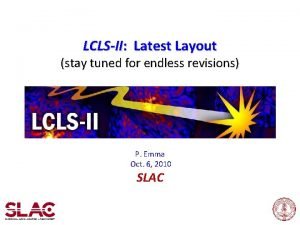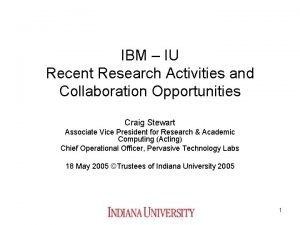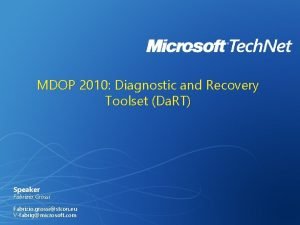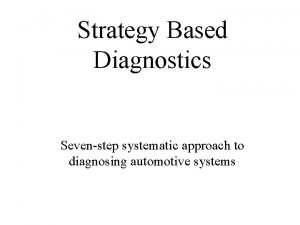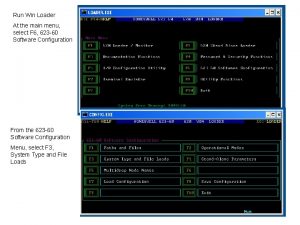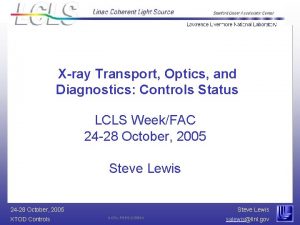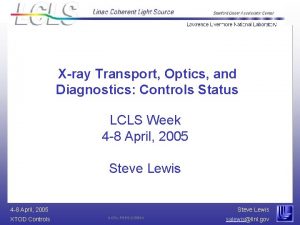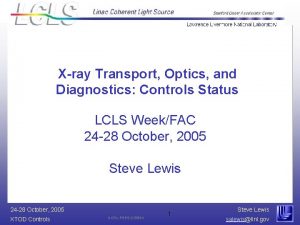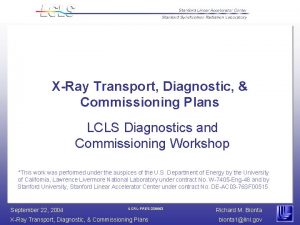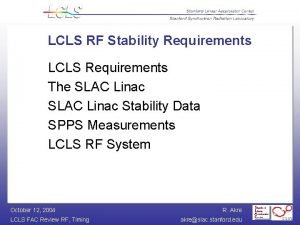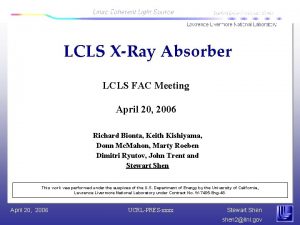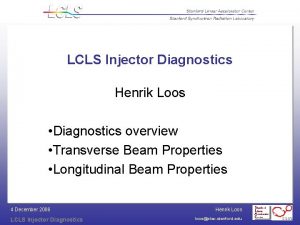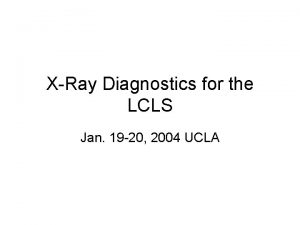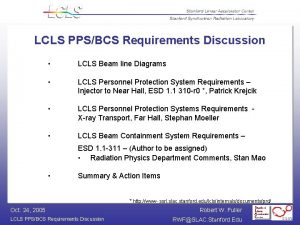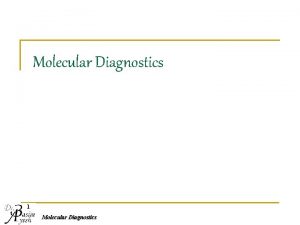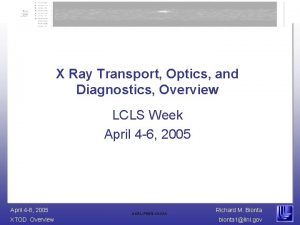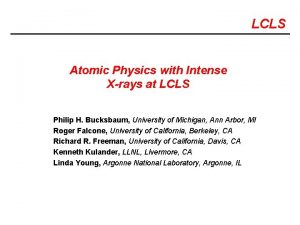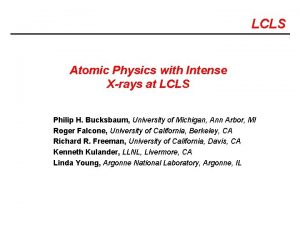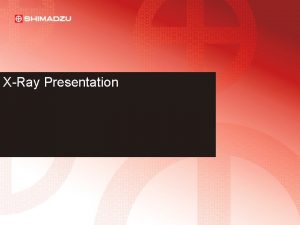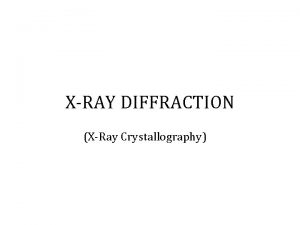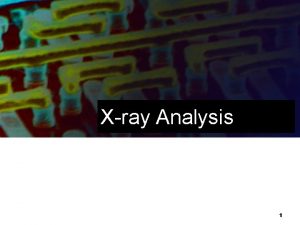Physics Requirements for LCLS XRay Transport and Diagnostics


















- Slides: 18

Physics Requirements for LCLS X-Ray Transport and Diagnostics John Arthur August 11, 2004 XTOD Physics Requirements John Arthur jarthur@slac. stanford. edu

From the LCLS Global Requirements document: The Project scope includes facilities for production and transport of a bright, high-current electron beam an undulator system in which the electron beam will generate the x-ray beam facilities for transport, diagnostics and optical manipulation of the x-ray beam endstations and related facilities for x-ray experiments conventional facilities for the accelerator systems and x-ray experiments a central lab office building to house support staff and researchers This talk will elaborate on the physics basis for the specification of the LCLS x-ray transport system and diagnostics August 11, 2004 XTOD Physics Requirements John Arthur jarthur@slac. stanford. edu

The X-ray Transport Systems August 11, 2004 XTOD Physics Requirements John Arthur jarthur@slac. stanford. edu

Where the X-ray transport systems are located Near Expt Hall Far Expt Hall ~420 m August 11, 2004 XTOD Physics Requirements John Arthur jarthur@slac. stanford. edu

Basis for transport requirements: The LCLS x-ray beam must be transported to the experimental stations without degradation Vacuum transport line. Pressure requirement for minimal absorption of LCLS beam over ~ 500 m is 10 -5 T. Additional requirement is that pressure at the ion pumps must be low enough to assure long pump life (>10 yrs). Transport line also serves a PPS function. Pipe must be large enough so that it cannot be hit by a mis-steered beam. Transport line must conform to SLAC vacuum standards, and LCLS standards for pumps, controllers, and gauges. August 11, 2004 XTOD Physics Requirements John Arthur jarthur@slac. stanford. edu

The X-ray Optics August 11, 2004 XTOD Physics Requirements John Arthur jarthur@slac. stanford. edu

Functions of the x-ray optics Confinement (masks, slits, local apertures) Intensity attenuation (gas attenuator, solid attenuator) Focusing (K-B mirror) Spectral filter (mirror low-pass filter, monochromator) Beam direction (flipper mirrors) Temporal filter (pulse split/delay) August 11, 2004 XTOD Physics Requirements John Arthur jarthur@slac. stanford. edu

High peak power (fluence) poses a challenge for x-ray optics Response of material to ultra-high power x-ray pulse is untested LLNL codes can describe all aspects of the response EXCEPT initial conversion of x-ray energy into hot electrons. Uncertainty due only to lack of understanding of non-linear response We have good arguments that the non-linear response will be negligible Therefore, we will use linear absorption cross sections with confidence LLNL will do precise calculations (assuming linear cross sections) as part of optics design Until those calculations are done, use conservative approximation based on known melting points of materials August 11, 2004 XTOD Physics Requirements John Arthur jarthur@slac. stanford. edu

FEE NEH Approximation assumes FEL pulse energy instantly deposited in atoms within absorption volume (using FEH linear absorption cross section). If resulting energy/atom much less than melt energy/atom, then the material will not be damaged. LLNL Expected LCLS fluence compared with melt fluence for various materials August 11, 2004 XTOD Physics Requirements John Arthur jarthur@slac. stanford. edu

Some proposed solutions to the peak power problem Low-z materials (Be, B 4 C, C) Grazing-incidence slits Grazing incidence Gas attenuator Distance from source Graded-density absorber August 11, 2004 XTOD Physics Requirements John Arthur jarthur@slac. stanford. edu

Basic specifications for slits and attenuators Slit aperture range 2 x 4 s beam size @ 800 e. V Slit precision 1 µm Attenuator range up to 104 at any energy 800 -8000 e. V Attenuator precision 1% of attenuation, steps 3/10/103/104 August 11, 2004 XTOD Physics Requirements John Arthur jarthur@slac. stanford. edu

X-ray focusing Produce high flux density K-B focusing mirrors Useful energy range 800 - 24000 e. V Focus size < 1 µm Efficiency >10% August 11, 2004 XTOD Physics Requirements John Arthur jarthur@slac. stanford. edu

X-ray mirrors for LCLS Energy low-pass filter Beam redirection Double-mirror low-pass filter Low-pass mirror critical energy variable 1200 e. V -9000 e. V Mirror mechanical stability beam jitter < 10% of beam size August 11, 2004 XTOD Physics Requirements John Arthur jarthur@slac. stanford. edu

X-ray monochromators Energy bandpass filter Energy range 800 e. V -24000 e. V Bandpass < 2 x 10 -4 Rapid scan range 10% August 11, 2004 XTOD Physics Requirements John Arthur jarthur@slac. stanford. edu

X-ray pulse split and delay Provides precise time delay between pulses Energy 8000, 24000 e. V Delay range 0 -200 ps Pulse split/delay using thin Si crystals August 11, 2004 XTOD Physics Requirements John Arthur jarthur@slac. stanford. edu

The X-ray Diagnostics X-ray diagnostics are required for characterization of the FEL and spontaneous radiation, as means of assessing SASE performance August 11, 2004 XTOD Physics Requirements John Arthur jarthur@slac. stanford. edu

Specifications for the x-ray diagnostics Position of beam centroid 5% of beam size Beam transverse dimensions 10% of beam size Beam divergence 10% of divergence Photon energy 0. 02% of energy Photon energy spread 20% of energy spread August 11, 2004 XTOD Physics Requirements John Arthur jarthur@slac. stanford. edu

Summary The XTOD group will provide facilities for transporting the LCLS x -ray beam, for measuring the beam characteristics, and for manipulating the characteristics in controlled ways A vacuum beam path system will transport the beam without degradation X-ray optical elements will aperture, attenuate, focus, and monochromate the x-rays A suite of x-ray diagnostics will allow characterization of SASE performance August 11, 2004 XTOD Physics Requirements John Arthur jarthur@slac. stanford. edu
 Lcls
Lcls Lcls
Lcls Lcls schedule
Lcls schedule Symport antiport uniport
Symport antiport uniport Membrane structures that function in active transport
Membrane structures that function in active transport Active and passive transport
Active and passive transport Erd commander 2010
Erd commander 2010 Mitel system administration and diagnostics download
Mitel system administration and diagnostics download Passive transport vs active transport venn diagram
Passive transport vs active transport venn diagram Active vs passive transport venn diagram
Active vs passive transport venn diagram Unlike passive transport, active transport requires *
Unlike passive transport, active transport requires * Primary active transport vs secondary active transport
Primary active transport vs secondary active transport Bioflix activity membrane transport active transport
Bioflix activity membrane transport active transport Isotonic in biology
Isotonic in biology Gm strategy based diagnostics
Gm strategy based diagnostics Duct diagnostics
Duct diagnostics Customer journey diagnostics
Customer journey diagnostics Winloader
Winloader Standard diagnostics korea
Standard diagnostics korea
